
Insects in the family Tettigoniidae are commonly called katydids, or bush crickets. They have previously been known as "long-horned grasshoppers". More than 8,000 species are known. Part of the suborder Ensifera, the Tettigoniidae are the only extant (living) family in the superfamily Tettigonioidea.

Ensifera is a suborder of insects that includes the various types of crickets and their allies including: true crickets, camel crickets, bush crickets or katydids, grigs, weta and Cooloola monsters. This and the suborder Caelifera make up the order Orthoptera. Ensifera is believed to be a more ancient group than Caelifera, with its origins in the Carboniferous period, the split having occurred at the end of the Permian period. Unlike the Caelifera, the Ensifera contain numerous members that are partially carnivorous, feeding on other insects, as well as plants.
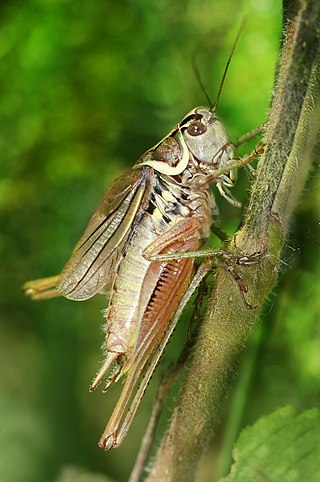
Roesel's bush-cricket, Roeseliana roeselii is a European bush-cricket, named after August Johann Rösel von Rosenhof, a German entomologist.
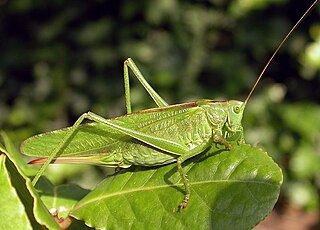
The Tettigoniinae are a subfamily of bush crickets or katydids, which contains hundreds of species in about twelve tribes.
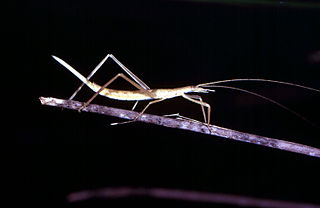
Kawanaphila is a genus of insects in family Tettigoniidae from Australia. It was described in 1993 by David C. Rentz.

Saga pedo is a species of wingless bush cricket from the southern half of Europe and western and central Asia. This brown or green bush cricket typically has a total length, from the head to the tip of the ovipositor, of up to 10.5 cm (4.1 in), but exceptionally it may reach 12 cm (4.7 in), which makes it one of the largest European insects and one of the world's largest Orthoptera. The head-and-body alone typically is 5–7 cm (2.0–2.8 in) long in adults, but may reach up to 7.8 cm (3.1 in).

Macroxiphus is a small genus of bush crickets or katydids distributed in Southeast Asia and Micronesia. The nymphs of the insects mimic ants.

Phaneroptera nana, common name southern sickle bush-cricket, is a species in the family Tettigoniidae and subfamily Phaneropterinae. It has become an invasive species in California where it may be called the Mediterranean katydid.

Yersinella raymondi, common name Raymond's Bush-cricket, is a species of "katydids crickets" belonging to the family Tettigoniidae subfamily Tettigoniinae. The scientific name Yersinella comes from the name of the entomologist who has described the species in 1860.
Panoploscelis is a genus of very large insects belonging to the true katydid tribe Eucocconotini, which is a subfamily of the Tettigoniidae. Like the other members of the suborder Ensifera, Panoploscelis are part of the insect order Orthoptera, which also contains crickets, grasshoppers and locusts. Members of this genus are among the largest katydids of the Neotropics.

Hexacentrus is the type genus of bush-crickets in the subfamily Hexacentrinae. Most species of this genus occur in Southeast Asia and in Africa.

Mecopodinae are a subfamily of bush crickets found in western South America, sub-Saharan Africa, and Asia. In Asia, the distribution includes India, Indochina, Japan, the Philippines, and Malesia to Papua New Guinea and Australasia, including many Pacific islands.

Conocephalinae, meaning "conical head", is an Orthopteran subfamily in the family Tettigoniidae.

Agraeciini is a large tribe of bush crickets or katydids in the conehead subfamily, Conocephalinae.
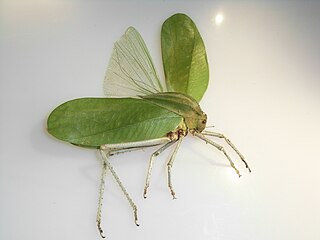
The Phyllophorinae is a subfamily of the bush crickets or katydids, found in east Malesia to Australia.

The Hexacentrinae, are a subfamily of predatory bush crickets or katydids. The type genus is Hexacentrus, which may be known as "balloon-winged" bush crickets/katydids etc., is also the most speciose and widespread in Africa and Asia.
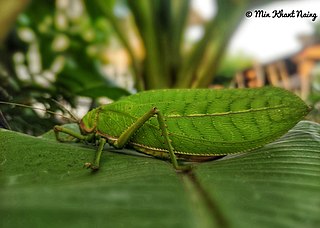
Pseudophyllus titan, the giant false leaf katydid, is a species of leaf-mimic bush-cricket of the subfamily Pseudophyllinae found in the canopy of tropical forests in Mainland Southeast Asia, Bangladesh, northeastern India, and southernmost China (Yunnan). It is among the largest species in the genus Pseudophyllus, which also makes it one of the world's largest Orthoptera, with a typical length of 13 cm (5.1 in) from head to tip of the folded wings and a wingspan of c. 23 cm (9.1 in). Like many other species of crickets and grasshoppers, the male is capable of stridulation, producing a relatively loud and distinctive, bird-like chirp; it usually stridulates ("sings") at night.

Zaprochilinae is a subfamily of bush-crickets found in Australia; the type genus is Zaprochilus.

Tettigoniidea is an infraorder of the order Orthoptera, with six extant families.

Caedicia simplex is a species of bush cricket, native to New Zealand and Australia. Its common name is the common garden katydid.




















